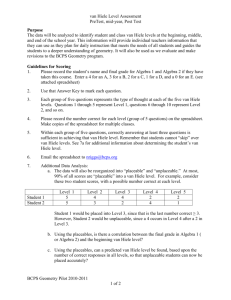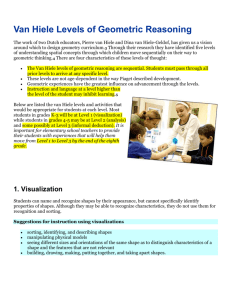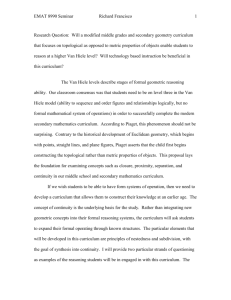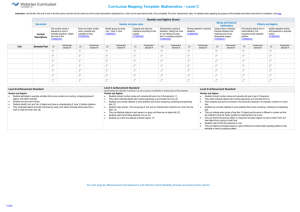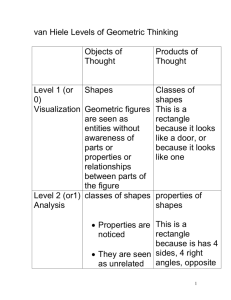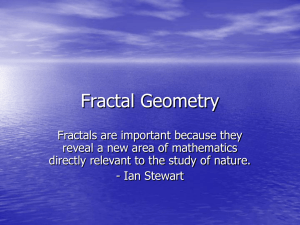Approaching tactual shape perception: Students` views and
advertisement
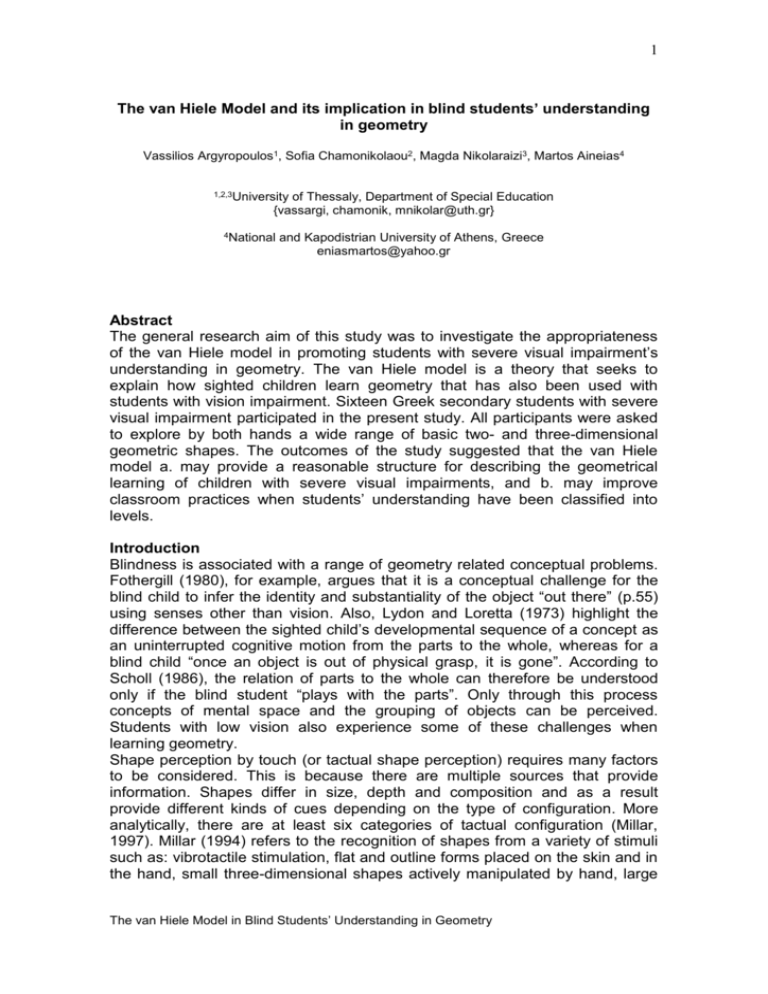
1
The van Hiele Model and its implication in blind students’ understanding
in geometry
Vassilios Argyropoulos1, Sofia Chamonikolaou2, Magda Nikolaraizi3, Martos Aineias4
1,2,3University
of Thessaly, Department of Special Education
{vassargi, chamonik, mnikolar@uth.gr}
4National
and Kapodistrian University of Athens, Greece
eniasmartos@yahoo.gr
Abstract
The general research aim of this study was to investigate the appropriateness
of the van Hiele model in promoting students with severe visual impairment’s
understanding in geometry. The van Hiele model is a theory that seeks to
explain how sighted children learn geometry that has also been used with
students with vision impairment. Sixteen Greek secondary students with severe
visual impairment participated in the present study. All participants were asked
to explore by both hands a wide range of basic two- and three-dimensional
geometric shapes. The outcomes of the study suggested that the van Hiele
model a. may provide a reasonable structure for describing the geometrical
learning of children with severe visual impairments, and b. may improve
classroom practices when students’ understanding have been classified into
levels.
Introduction
Blindness is associated with a range of geometry related conceptual problems.
Fothergill (1980), for example, argues that it is a conceptual challenge for the
blind child to infer the identity and substantiality of the object “out there” (p.55)
using senses other than vision. Also, Lydon and Loretta (1973) highlight the
difference between the sighted child’s developmental sequence of a concept as
an uninterrupted cognitive motion from the parts to the whole, whereas for a
blind child “once an object is out of physical grasp, it is gone”. According to
Scholl (1986), the relation of parts to the whole can therefore be understood
only if the blind student “plays with the parts”. Only through this process
concepts of mental space and the grouping of objects can be perceived.
Students with low vision also experience some of these challenges when
learning geometry.
Shape perception by touch (or tactual shape perception) requires many factors
to be considered. This is because there are multiple sources that provide
information. Shapes differ in size, depth and composition and as a result
provide different kinds of cues depending on the type of configuration. More
analytically, there are at least six categories of tactual configuration (Millar,
1997). Millar (1994) refers to the recognition of shapes from a variety of stimuli
such as: vibrotactile stimulation, flat and outline forms placed on the skin and in
the hand, small three-dimensional shapes actively manipulated by hand, large
The van Hiele Model in Blind Students’ Understanding in Geometry
2
three-dimensional objects which cannot be grasped in the hand, small
continuous raised outlines and very small raised-dot patterns (e.g. braille).
It has been observed that the identification of geometric shapes by individuals
who are blind is based mainly on the exploration of their angles and curves and
not of their sides. Also, it seems that the characteristics of three-dimensional
objects are learned easier and faster than those of two-dimensional ones
(Ittyerah, 2010; Withagen et al., 2011). Finally, it seems that individuals with
blindness prefer to use their indexes and thumbs when they actively manipulate
objects (Heller, 1989).
Touch is an inter-sensory process. All receptors and cerebral areas must cooperate to create the outcome, tactual shape perception (Roberts & Wing,
2001).
The general research aim of this study was to investigate the appropriateness
of the van Hiele model in students with vision impairment’s understanding in
geometry. According to this model, the learner, assisted by appropriate
instruction, passes through five levels beginning with recognition of shapes as a
whole [level 0 – “Recognition”], progressing to discovery of the properties of
figures and informal reasoning about these figures and their properties [levels 1
and 2 – “Analysis” and “Ordering” respectively], and culminating in a rigorous
study of axiomatic geometry [levels 3 and 4 – “Deduction” and “Rigour”
respectively) (Fuys, Geddes, & Tischler, 1988). The previous levels of
understanding form a hierarchy and are mutually dependent and cumulative in
character.
“The Van Hiele Model identifies five levels of thinking in geometry.
According to this model, the learner, assisted by appropriate instructional
experiences, passes through these levels beginning with recognition of
shapes as a whole (level 0), progressing to discovery of the properties of
figures and informal reasoning about these figures and their properties
(levels 1 and 2), and culminating in a rigorous study of axiomatic
geometry (levels 3 and 4)” (Fuys, Geddes, & Tischler, 1988: p1).
The research objectives were as follows: a. to assess and describe students
with severe vision impairment’s levels of understanding while exploring small
two- and three-dimensional manipulative geometric objects utilizing the van
Hiele model, and b. to consider implications of teaching methods based on the
utilization of the van Hiele model.
Method
Participants
Sixteen secondary students from Greece with severe visual impairments (i.e.
those who are blind and those with low vision) participated in the present study
(age, M=16.94, SD=0.93). The teachers provided information about the visual
acuities of the students, prognoses, and etiologies of the visual impairments. Of
the 16 students, 10 were reported to have visual acuities of less than 20/200
and 6 had visual acuities between 20/100 and 20/200. The teachers did not
provide information about the students’ visual fields and identified all the
students as legally blind (with visual acuities of less than 20/200 or visual fields
The van Hiele Model in Blind Students’ Understanding in Geometry
3
of less than 20 degrees). Finally, of the 16 students, none had additional
disabilities, six had light perception only, eight had congenital conditions, and
eight had adventitious conditions. (see Table 1).
<Please Insert Table 1 around here>
Stimulus Material
Two- and three-dimensional geometric objects were used in this study, which
could be actively manipulated by both hands by the participants. In total, 31
shapes were used, out of which 21 were two-dimensional (six triangles, 10
quadrilaterals, three polygons and two circles) and 10 three-dimensional ones
(three pyramids, two cones, two spheres and three prisms). All shapes were
constructed of plastic and each was unique.
Research procedure
The participants were asked to verbally describe the properties of the shapes in
question while exploring them. All experiments were video-recorded and the
camera shot focused exclusively on the participants’ hands. Permission for
video recording was sought and granted from the students and their parents. A
class was selected without disrupting students’ daily programme in class.
Subjects were videotaped individually in 40 to 45-minute sessions. A
preliminary phase took place before the main experiments. During this phase all
participants had the chance to work out some shapes – which were not included
in the main experiments – and comment on their attributes, texture and
material. In turn, each participant was given a tray with all shapes and he/she
randomly picked up one by one, without time limit and described the shape.
Data analysis
Data analysis was based on video recording sessions. In order to analyze the
data linked to the first research objective, the researchers viewed the video
multiple times and categorized all participants’ verbal explanations and
descriptions according to the five levels in the mastery of geometry based on
the van Hiele model of thinking.
The authors used the coding system of Fuys et al. (1988) to describe the quality
of students’ responses as follows: a. students often did not respond consistently
at the same level on a task, and the following codes were used in these
situations: 0-1 indicates that the student’s understanding was in transition from
level 0 to level 1, b. sometimes students were unable to respond to all the
questions. In this case the omissions were indicated by a dash (--), c. when
students had incomplete understanding of basic concepts (angle, curve or
straight line) and also had little or no facility with the related terminology, then
this was indicated by 0*, and d. sometimes students responded spontaneously
without even being asked questions or given instructions – for example, a
student might have spontaneously described some properties of a shape. Other
students needed a prompt; for example, “do you think the length of each side of
a square is the same or not? or “what about the sides of a rectangle, are they
equal or not?”. Frequently guidance was needed, for example, “can you count
the corners for me?” or “Can you show me the sides and we can count them
together”. The amount of the above during questioning was denoted by: s =
spontaneous, p = prompt and g = guidance.
The van Hiele Model in Blind Students’ Understanding in Geometry
4
Results
Table 2 provides an approximate classification into van Hiele’s levels of
understanding regarding two- and three-dimensional shapes in terms of a. their
recognition (basic concepts), b. their properties, and c. their patterns.
Basic Shapes
It seemed that the participants’ level of understanding, according to Table 2, lies
mostly within a transitional phase between levels 0 and 1 (33.13%). Also, Table
2 provided evidence of five students whose thinking or/understanding was
categorised between level 1 and 2.
<Please Insert Table 2 around here>
Nevertheless, most of the participants seemed to be level 0 thinkers (see Table
3; total percentage response 50%). It seemed that participants were familiar
with basic geometrical shapes such as circles, triangles, rectangles or squares
but while trying to identify the set of the polygons they became confused and
sometimes frustrated. Their thinking showed a failure to analyse the shapes in
terms of their parts and properties (e.g. hexagon with no sides or trapezium with
six or seven corners). They had memorised the names of some shapes without
linking them with their corresponding properties. Also their grasp of
mathematical terminology was poor and for the most part they remained at level
0 (Table 2).
The rest of the participants seemed to be in a phase of transition from level 0 to
level 1 but mostly they remained at level 0. They could recognise a shape with
ease and use the same method to identify shapes even though they did not
know their names (e.g. octagon). It is worth mentioning that all students tried to
analyse and work out the three-dimensional shapes as two-dimensional. None
of them did remember the right terminology (especially for the prisms) and they
were confused when they were counting corners. It seemed that they did not
have a system of counting with stable reference points. Usually, they placed
one of their hands on one of the corners of the three-dimensional shape to have
a starting point to explore from and with the forefinger of the other hand they
traced the corners of the shape going round and round.
Properties
The thinking of the participants with respect to the properties of two dimensional
shapes was almost uniformly at level 0 with an inclination to level 1 (56.25%,
Table 3). The vast majority had an incomplete understanding of the terms “side”
and “angle” and most times their recognition was on an “I felt it” basis rather
than on the basis of the properties of the shapes in question. It could be argued
that the participants’ approach was a holistic one based on their past
experience without analysing the properties of the shapes and then draw a
conclusion through this set of properties. Only three participants (I, M, and P,
see Table 2) seemed to be very confident about the way they counted angles or
sides. They made a clear distinction between the terms “sides” and “angles” but
they preferred to use the term “points” instead of angles.
Patterns
Regarding patterns of the two dimensional shapes, eight of the participants (A,
D, G, J, K, L, N, and O, see Table 2) did not seem to be aware that every twodimensional shape has the same number of sides and angles. Two participants
The van Hiele Model in Blind Students’ Understanding in Geometry
5
(B and C) although they could figure out the pattern of the same number of
sides and corners, they could not generalize.
Also, six participants (E, F, H, I, M, and P, see Table 2) did not face any
problem with patterns; instead, after they became familiar with the procedure
they started to give spontaneously all the information about a shape; for
example, when they picked up the rectangle without the researcher’s
intervention they started to give information about the name of the rectangle,
the number of the sides, the number of the corners and mentioned the pattern
of the same number. On the contrary, big confusion took place with all threedimensional shapes apart from spheres.
<Please insert Table 3 around here>
An overview of the results
None of the participants reached any generalisation (they did not discover the
pattern that the number of the sides of a two dimensional shape is always the
same as the number of its angles) but participants M and P did reach this
pattern; for this, they gave spontaneously answers which referred to the former
logical scheme.
Below a synopsis is given in terms of the strategies used by the students for
identifying the shapes in question: 1) Holding the shape in front of them (near
their face or near their chest); marking an angle with a thumb and exploring the
shape with the other hand while rotating it. This is actually an exploration of a
two-dimensional shape in a three-dimensional way, and 2) Putting the shape
firmly on the desk. This represents an exploration of a two-dimensional shape in
a two-dimensional way. The desk may be considered as the Cartesian
coordinate system and the shape could be recognised only from its twodimensional properties.
Discussion
The first research objective of the present study referred to the applicability of
van Hiele theory in describing blind students’ levels of understanding while
exploring small two- and three-dimensional manipulative geometric objects. The
analyses of the video-taped sessions provided rich information about the
students’ levels of thinking. As described in Tables 2 and 3, a single level is not
adequate to describe and classify students’ thinking. It could be suggested that
a synthesis of levels might provide a more integrated “picture” of students’
understanding in geometry. Nevertheless, we argue that the van Hiele model
provides a reasonable framework for describing the geometrical understanding
of students with blindness and sheds light on students’ insights.
There is a consensus in most of the studies so far conducted that students tend
to progress through a five-level sequence in a certain order and cannot master
one level (Level n) if they have not mastered the previous one [(Level (n-1)]
without instruction; when the opposite happened it was concluded that the
student had performed only algorithmically on that higher level (Mayberry,
1983). An interesting point of view was expressed by a triad of researchers
(Guitierrez, Jaime, & Fortuny, 1991) who distinguished “degrees of acquisition
of a given level” (p. 238). They had noticed that many students’ answers are not
entirely at a specific level but were laid out in a combination of consecutive
levels (p. 237). In specific, they claimed that “the van Hiele levels are not
The van Hiele Model in Blind Students’ Understanding in Geometry
6
discrete and we need to study in more depth the transition between levels” (p.
238).
In the present study, it seemed that most students’ showed a dominant level of
thinking, with the presence of other levels as well. For this reason, the
expression “this student is in transition between levels” (Burger & Shaughnessy
1986; Fuys et al., 1988; Usiskin 1982) fits in this study and also is often used by
the researchers mentioned above.
Regarding the second research objective, it can be supported that the van Hiele
model, provides a reasonable structure for describing the geometrical learning
of children with visual impairments. The analyses of the video-taped sessions
provided insight and valuable information: a. on students’ levels of thinking in
geometry (Tables 2 & 3), and b. on factors which were affected students’
performances at different stages of the task. (e.g., vocabulary, tactile
perception, misconceptions, learning styles - see Overview of the results).
The implications with respect to geometry may concern various aspects such as
a. improvement of classroom practice when students’ understanding has been
classified into levels, and b. teacher’s training in order to facilitate as much as
possible students’ understanding using all he parameters of tactual shape
perception (Millar, 1997).
Pegg (1985) praises the dynamic character of van Hiele’s model, stressing that:
The van Hiele theory is most useful for teachers in the advice it gives to
planning for instruction. The fact that a pupil’s thinking can be classified at
a particular level is not important itself. What is important are the
implications to the teacher of the type of content and methods that are
appropriate and the need to respond to pupils at their level of thinking. (p.
8)
In total, it is argued that individuals’ understanding does not fit neatly into one
level or another (i.e. van Hiele’s levels). The use of “levels” satisfies the
hierarchical structure of geometry or maths in general but it is not sufficiently
refined to characterise thinking. This position can be justified by the following
points: 1) the number of levels seem to be flexible, 2) performances generally
seem to be spread across levels, and 3) performances are determined by what
is taught. This implies that the nature of the van Hiele’s levels are more
psychological than logical and undoubtedly has a bearing on teaching
processes (Clements & Battista, 1992). That is to say, that progress from one
level to the next is more dependent upon instruction than on age or biological
maturation (Fuys et al., 1988). Tools such as the van Hiele model are useful to
research on hierarchical thinking but more research is needed in terms of the
reliability of the levels.
Acknowledgements. This research has been co-financed by the European
Union (European Social Fund – ESF) and Greek national funds through the
Operational Program "Education and Lifelong Learning" of the National
Strategic Reference Framework (NSRF) under the Research Funding Project:
“THALIS-University of Macedonia- KAIKOS: Audio and Tactile Access to
Knowledge for Individuals with Visual Impairments”, MIS 380442.
The van Hiele Model in Blind Students’ Understanding in Geometry
7
References
Burger, F. W., & Shaughnessy, J. M. (1986). Characterising the van Hiele levels
of development in geometry. Journal for Research in Mathematics
Education, 17(1), 31-48.
Clements, D. H., & Battista, M. T. (1992). Geometry and Spatial Reasoning. In
D. A. Grows (Ed), Handbook of Research on mathematics teaching and
learning (pp420-464). New York.
Fothergill, C. (1980). Ego development and the foundations of personality in
blind infants. Insight, 1(3), 54-58.
Fuys, D., Geddes D., & Tischler, R. (1988). The Van Hiele Model of Thinking in
Geometry among Adolescents. New York: Brooklyn College.
Gutierrez, A., Jaime, A., & Fortuny, J. M. (1991). An Alternative Paradigm to
Evaluate the Acquisition of the van Hiele levels, Journal for Research in
Mathematics Education, 22(3), 237-251.
Heller, M. A. (1989). Picture and pattern perception in the sighted and the blind:
the andvantage of the late blind. Perception, 18 (3), 379-389.
Ittyerah, M. (2010). Haptic touch and hand ability. In M., H. Zadeh, (ed.),
Advances in Haptics, 25, 463-475.
Lydon, W. T., & Loretta, G. M. (1973). Concept development for visually
handicapped children. American Foundation for the Blind.
Mayberry, J. (1983). The van Hiele levels of geometric thought in
undergraduate preservice teachers. Journal for Research for Mathematics
Education, 14, 58-69.
Millar, S. (1994). Understanding and Representing Space. Theory and Evidence
from Studies with Blind and Sighted Children. Oxford: Clarendon Press.
Millar, S. (1997). Reading by Touch. London: Routledge.
Pegg, J. (1985). How children learn geometry: The van Hiele theory. The
Australian Mathematics Teacher, 41(2), 5-8.
Roberts, R., & Wing, A. M. (2001). Making sense of active touch. British Journal
of Visual Impairment, 19(2), 48-55.
Scholl, G. T. (1986). Foundations of Education for Blind and Visually
Handicapped Children and Youth: Theory and Practice. New York:
American Foundation for the Blind.
Usiskin, Z. (1982). Van Hiele levels and achievement in secondary school
geometry (Final report of the cognitive development and achievement in
secondary school geometry project). Chicago, IL: University of Chicago,
Department of Education.
Withagen, A., Kappers, A., Vervloed, M., Knoors, H., & Verhoeven, L. (2011).
Haptic object matching by blind and sighted adults and children. Acta
Psychologica, 139, 261-271.
The van Hiele Model in Blind Students’ Understanding in Geometry
8
Table 1: Characteristics of the participants
Congenitally blind
Sex agea LP
Adventitiously blind
Se agea LP cause
x
F
16 No
PHPV
M
19 No
Glaucoma
M
17 No
Optic nerve atrophy
M
16 No
Glaucoma
F
16 No
Optic nerve atrophy
F
17 Yes Iridocyclitis
M
17 Yes Congenital cataract
F
17 Yes Glaucoma
F
16 No
RP
F
16 No
M
16 Yes RP
F
18 Yes M
18 Yes RLF
F
17 No
M
18 No
RLF
M
17 No
Note: F= female; M= male; LP= light perception; PHPV= persistent hyperplastic
primary vitreous; RP = retinitis pigmentosa; RLF=retrolental fibroplasias.
a
Age given in years.
Cause
The van Hiele Model in Blind Students’ Understanding in Geometry
9
Table 2. Secondary Students’ Level of Thinking on 2-D and 3-D shapes.
CATEGORIES
PARTICIPANTS
(N =16)
Shapes
Triangles
A
B
01
0*
0*
01
0*
01
0*
01
0*
01
0*
C
VAN HIELE LEVELS OF UNDERSTANDING
D E
F
G H I
J
K L M
01
01
01
0*
0*
01
01
12
12
12
01
12
01
01
01
Circles
-01
0*
12
-12
-01
Triangular
Pyramid
Square Pyramid
--
0*
01
--
--
0*
01
-01
0*
12
0*
01
-01
0*
12
0*
01
Parallelograms
Rectangles
Rhombuses
Squares
Trapeziums
Pentagon
0*
Hexagon
01
12
12
12
2*
01
2*
12
2
01
12
12
12
12
-01
2
01
12
12
12
01
01
01
01
01
0*
01
0*
01
0*
12
0*
01
0*
01
01
Octagon
Basic
Concepts
Pentagonal
Pyramid
Sphere
--
-01
12
12
12
12
12
01
01
01
01
12
0
--
0
0
--
0
0
12
-01
01
01
01
---
0
12
12
12
12
---
Cone
Cube
Cylinder
01
01
12
0*
12
01
01
01
12
12
2
0*
2
0*
12
12
12
12
01
01
01
12
12
12
12
---
01
01
0*
01
0*
01
01
01
01
0*
01
0*
01
0*
01
0*
01
01
0*
0*
01
0*
01
01
01
01
--
--
--
--
--
--
-01
-01
0*
0*
-01
01
--
--
0*
0*
-01
-01
---
12
12
2*
12
2
12
12
12
01
12
01
01
01
12
01
01
01
---
-- 0* 0* 0* 0* 0*
0* 0*
Triangular prism -- --- -----Square prism
-- --- -----Pentagonal
prism
-- --- ---- ------ -- -Properties
Number of
sides/number of
0- 0- 0- 0- 1- 0- 0- 1- 01angles
0* 1g 1s 1g 1p 2s 1g 1g 2g 1g 0* 0* 2p
Patterns
Same number
of sides and
0- 0- 0- 0- 0- 0- 0- 1- 01corners
-- 1g 1s 1g 1p 1
1g 1g 2g 1g -- -- 2p
Note: Level 0 = Recognition/ Level 1 = Analysis/ Level 2 = Ordering/ Level 3 = Deduction/ Level
4 = Rigour
Key: (--) = Unable to respond/ 0* = Weak response/ g = responded with guidance/ p =
responded after prompting/ s = spontaneous response
The van Hiele Model in Blind Students’ Understanding in Geometry
N
O
P
0*
01
0*
01
0*
01
12
12
0*
01
0*
01
0*
01
01
01
01
01
01
01
01
01
01
01
---
0*
-01
01
01
01
---
2
01
12
12
12
12
12
12
12
12
12
12
12
---
--
--
--
01g
0*
12s
01g
0*
12s
0*
0*
-01
---
2
0*
10
Table 3. Percentage distribution of van Hiele’s levels of understanding for all
participants (N = 16)
0
0*
0-1
VAN HIELE LEVELS
1-2
2*
2
3
4
Basic Concepts
(2-D & 3-D
Shapes)
2.19% 16.85% 33.13% 19.7% 0.94% 2.19% 0% 0%
Properties
Counting the
number of
sides/number of
angles (only for
2-D Shapes)
0%
18.75% 56.25%
25%
0%
0%
0% 0%
Patterns
Compare the
number of sides
and corners (only
for 2-D Shapes)
0%
6.25% 56.25% 18.75%
0%
0%
0% 0%
Key: (--) = Unable to respond/ 0* = Weak response/ g = responded with guidance/ p =
responded after prompting/ s = spontaneous response
The van Hiele Model in Blind Students’ Understanding in Geometry
--
25%
0%
18.75%
